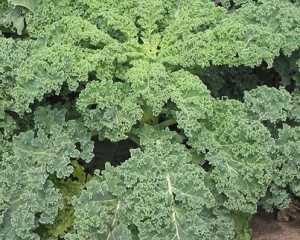How to Grow Kale – A Guide to Growing Kale
 Kale
Kale
Kale or Borecole as it was known is one of the easiest leafy brassicas to grow and it stands well in winter as one of the few fresh greens available on the plot. Kale isn’t a popular crop, many found the flavour bitter but more modern strains have improved the taste and, like sprouts and cabbage, much depends on how it is cooked. It’s a nutritious vegetable providing vitamins C, A and K as well as the highest level of vitamin E of all the vegetables.
Kale comes in two main types, flat leaved (rape kales) and curly leaved which are still referred to as borecoles. Breeders have recently released Fizz, which is ideal for salad leaves, or, if grown at wider spacings, will be more productive with larger leaves that can be used for cooking. The leaves look more like rocket than a traditional kale.
Sowing and Growing Kale
Unlike the other leaf brassicas, kale is still fairly near to it’s wild ancestry and because of this doesn’t require a very rich soil to grow well. It certainly needs nitrogen but land that has been manured the year before should provide enough. Otherwise do not feed as this will cause soft and sappy growth to go too tall and it won’t stand the winter winds and chills
The flat leaved kales do not like being transplanted and should be sown in situ. Usually sow half a dozen seeds 1cm deep in stations 60cm apart in staggered rows 75cm apart. Thin to the strongest seedling and protect against slugs.
The curly leaved types can be transplanted but do better started in 3″ pots with a 50/50 mix of soil and compost to start. Plant out at the same spacings as the flat leaved.
Sowing takes place in April or May and usually planting out the borecoles in July. Keep weed free by hoeing until established when it will dominate and shade out weed growth. Water in dry periods and that’s about it until harvest time.
Pests and Problems with Kale
Being near its wild ancestors, kale is tough and resists most of the brassica problems. If there is a high load of clubroot spores in the soil it will succumb but if a light load and the pH is near neutral it isn’t bothered.
Caterpillars can be a problem but kale seems to be a second choice for a butterfly looking to lay eggs. Keep an eye out nonetheless . The same goes for aphids etc. See the page on brassica pests and problems.
Most often you will not have any problems at all with kale.
Harvesting and Cooking Kale
The crop will be ready in November or December, and continue to stand on through to March. I’ve heard it said that there is more skill required for harvesting than growing kale. Certainly it does require a little thought.
Go down the row of plants and remove a few young leaves from the crown of each plant until you have enough. This will also encourage the development of side shoots which you can pick in the same way. Cutting with a knife or sharp scissors is usually the best way.
Do not pull old leaves, the flavour will certainly be bitter. You can also grow kale at close spacing and use the baby leaves in salads but to be honest I don’t like the flavour raw no matter how healthy. Tastes differ so you should try for yourself.
Steaming works well with kale but I prefer it cooked as I do cabbage, it also works well replacing the cabbage in this cabbage and bacon recipe.
Varieties of Kale Seed
Dwarf Green Curled – Dark, tightly curled leaves. Excellent quality, very cold hardy, good for difficult or windswept gardens or poor wet soils.
Darkibor F1 Seeds – Superb borecole, producing many dark-green, tightly curled leaves for picking throughout late autumn and winter. Very winter hardy. A superb source of tasty and highly nutritious autumn, winter and spring ‘greens’. Resistant to very bad winter conditions.
Fizz Seed (Borecole) – The result of British breeding in new brassica leaf shapes and textures, Fizz is a fast growing, upright, deeply lobed variety. Ideal for salad leaves, or, if grown at wider spacings, will be more productive with larger leaves that can be used for cooking. Mature plants are very winter hardy.
Redbor F1 Seeds (AGM) – Attractive purple/red leaves, good winter hardiness and excellent tolerance to pests and diseases, Redbor will make a delicious, nutritious and beautiful addition to your vegetable or flower garden. A superb source of tasty and highly nutritious autumn, winter and spring ‘greens’. Resistant to very bad winter conditions.



